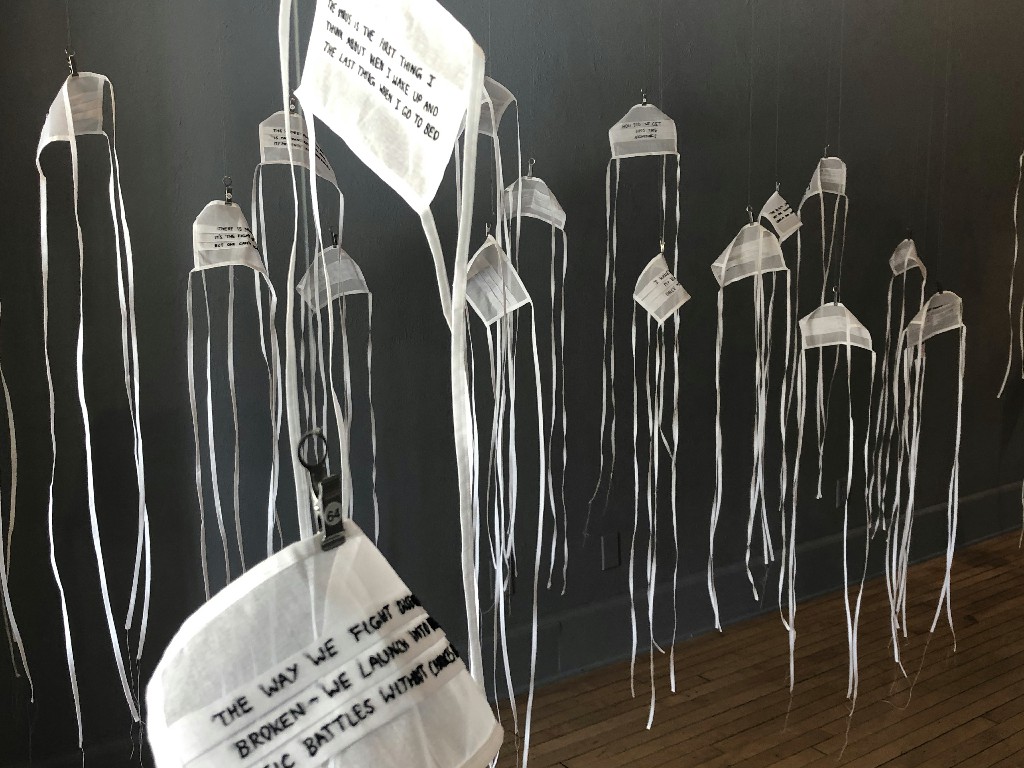As we move into autumn of 2020, and therefore closer to the end of the year, our initial shock and turbulent reactionsdue tothe impact of Covid19 have worn down to dull acceptance and pragmatic handling of altered daily routines. There is also a degree of hope, as news of vaccines and human tests by pharmaceutical companies make way into the headlines. Artists, always on the fringes of the economy, have perhaps been more fortunate than many, in having access to creative expression as a means of digesting, processing and externalizing the complex and multilayered experiences of the past months.

Nirmal Raja, with her ongoing project ‘Feeble Barriers – Documenting the time of Covid’ addresses the raw and challenging space of a frontline warrior’s experience. A multi-disciplinary artist based in Milwaukee (WI), USA, and Raja’s evolving repertoire includes drawing, print, sculpture, installation, and video. She uses her work to explore identity, memory, the human condition and the perception of time, among other things. She has often explored textile and thread as a means of broadening the formal notions of line, texture and surface, besides a conceptual investigation of difference and separation, filtering and mapping.For this project, she has hand embroidered quotes of various healthcare workers from different parts of the world onhandmade cotton organdy masks, transforming a global symbol of the coronavirus pandemic into an interface for sharing and communication. She recently exhibited 82 masks from the series at Grove Gallery, Milwaukee, with statements and words that represent the concerns, fears, and encounters of individuals working in the forefront of medical emergencies in different nations, as they witness a continued impact of COVID19 on patients.

“The mask has become a symbol for many conflicting ideas today- protection and consideration for others but also fear and partisanship. This thin piece of fabric has become a fault line where political identities are determined when it should simply be what it is- a feeble barrier against a pandemic. Many stories are being written on it- some about last breaths, some about courage and valor, some about love, some about inequality, some about survival, some about the ripple effects of COVID 19. Feeble Barriers is a record of our times as seen through the eyes of health care workers as we battle a mysterious monster in the dark.” says the artist in her statement.
Bleak words like “Will I take this home? Will I be next?” – submitted via text by a registered nurse in Milwaukee on April 15th; or “So hard for families to make life and death decisions on the phone” Submitted via text message by critical care physician in Milwaukee on April 6th, highlight the constant anxiety and pain of the health workers, many of them forced to leave their own loved ones for long durations and work overtime in order to save others. “I am not hero. I just wanted to help others in a way that I could”– came from Elizabeth “Buffy”Riley, an RN who left Wisconsin to help healthcare workers in NYC, or “My patient’s family is demanding better care but we are doing all we can. They just can’t see it!” – shared by a critical care physician in Milwaukee on May 1st, bringing to the fore the human tendency to rely on extremes, of either glorifying or blaming those in the frontlines. Words of love and hope, angst and anger, even humor and sentiments of relief – all became part of Raja’s personal effort to documentand articulate human emotions andto share nuances of people’s vulnerability and resilience through this disorienting period.

The masks as objects are deeply relatable – having become essential accessories that form a thin partition between danger and safety. We have seen how they are used and misused, discarded, ornamented, cursed and blessed. The adornment of the fabric with words, spoken from the very mouths that they are meant to cover, is a poignant act that the artist is transforming into one of artistic resonance. The voices are seen and heard, and their experiences and contributions will be remembered. They are tangible memories of an unprecedented time in contemporary history.
As the virus traversed the globe, it has been repeatedly mentioned that ‘it’ sees no caste or creed, colour or race – that anyone could be affected regardless of their identity or place. However, the differences run deep where privilege is concerned, and the choices that some have, to remain isolated. Healthcare workers do not have the luxury of the choice – “…first responders and essential workers continue their jobs with danger lurking at every turn. They face each day not knowing if they will continue to be the same that night.”
Nirmal Raja hopes to continue the series until she completes the number 101 that has its own symbolism in Indian spiritualism. In parallel, she has begun another project ‘Pandemic Impulses’ on Instagram, that invites people from anywhere in the world to share personal rituals or daily acts that are part of their coping methods through the lockdown.
Raja balances her arts practice with curatorial projects that explore intersectional identity, and she often provides a platform for underrepresented artists belonging to diverse cultural backgrounds. She is a former Mentoring Resident at Red Line Milwaukee, an urban arts incubator, and is now a mentor for the Milwaukee Artists Resource Network.
Lina Vincent

